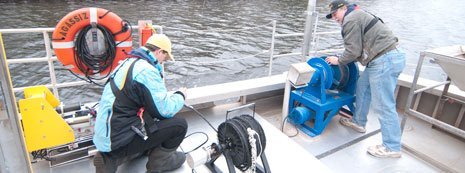Title
Mechanical vibration for the control of membrane fouling in direct contact membrane distillation
Document Type
Article
Publication Date
1-22-2019
Abstract
One of the biggest challenges for direct contact membrane distillation (DCMD) in treating wastewater from flue gas desulfurization (FGD) is the rapid deterioration of membrane performance resulting from precipitate fouling. Chemical pretreatment, such as lime-soda ash softening, has been used to mitigate the issue, however, with significant operating costs. In this study, mechanical vibration of 42.5 Hz was applied to lab-scale DCMD systems to determine its effectiveness of fouling control for simulated FGD water. Liquid entry pressure and mass transfer limit of the fabricated hollow fiber membranes were determined and used as the operational constraints in the fouling experiments so that the observed membrane performance was influenced solely by precipitate fouling. Minimal improvement of water flux was observed when applying vibration after significant (~16%) water-flux decline. Initiating vibration at the onset of the experiments prior to the exposure of foulants, however, was promising for the reduction of membrane fouling. The water-flux decline rate was reduced by about 50% when compared to the rate observed without vibration. Increasing the module packing density from 16% to 50% resulted in a similar rate of water-flux decline, indicating that the fouling propensity was not increased with packing density in the presence of vibration.
Publication Title
Symmetry
Creative Commons License

This work is licensed under a Creative Commons Attribution 4.0 International License.
Recommended Citation
Huang, F. Y.,
Medin, C.,
&
Arning, A.
(2019).
Mechanical vibration for the control of membrane fouling in direct contact membrane distillation.
Symmetry,
11(2).
http://doi.org/10.3390/sym11020126
Retrieved from: https://digitalcommons.mtu.edu/cee-fp/65
Version
Publisher's PDF


Publisher's Statement
© 2019 by the authors. Licensee MDPI, Basel, Switzerland. Publisher's version of record: https://doi.org/10.3390/sym11020126